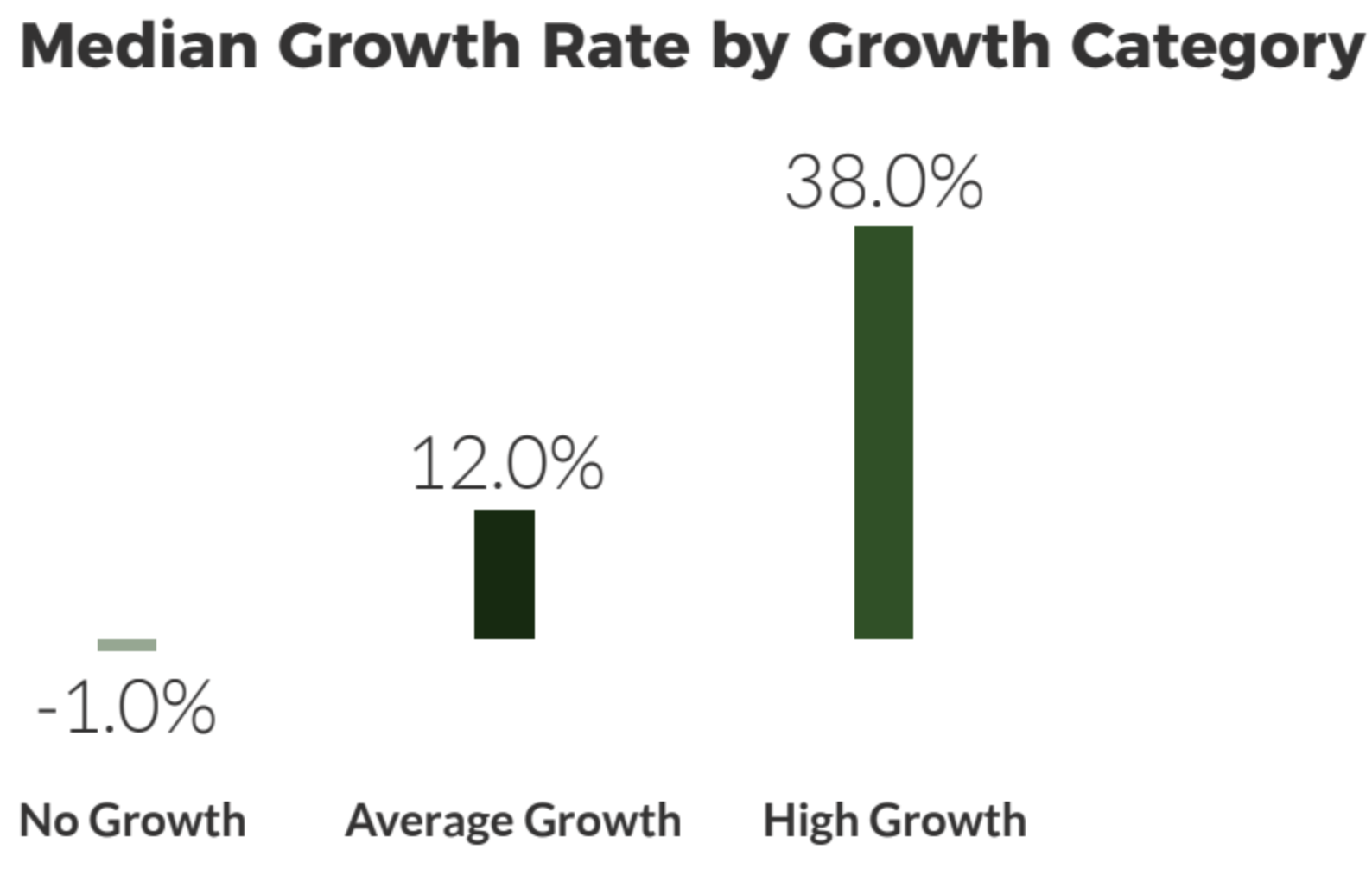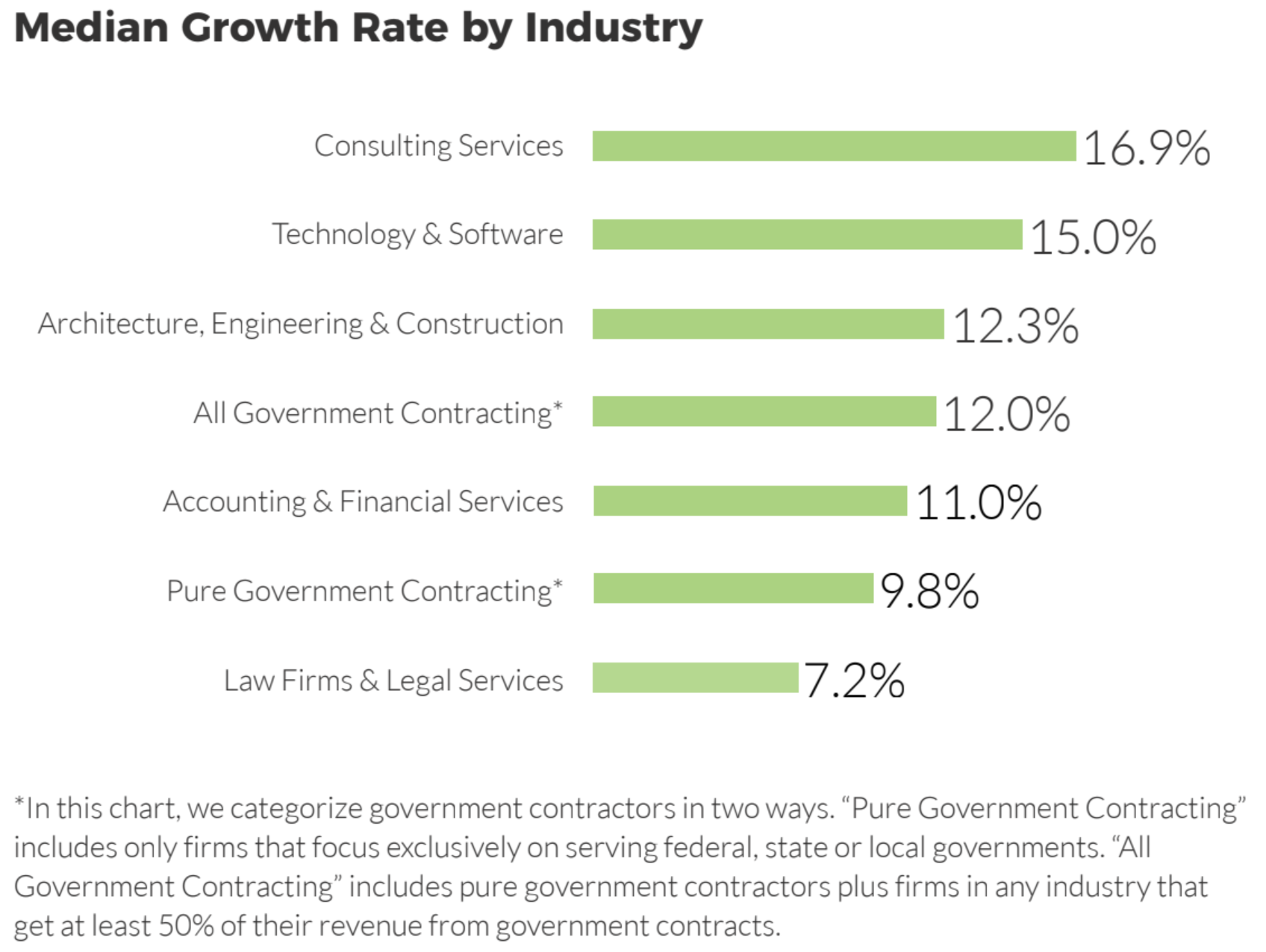New areas of government spending are creating more opportunities for government contractors at the federal, state, and local levels. But recent data from the Hinge Research Institute suggests that some business-to-government (B2G) firms are built to benefit more than others.
While average B2G firms grew a rate of about 12% last year, an elite group is growing 3X faster—year after year. How do they do it?
Hinge has spent the past fifteen years researching the marketing strategies and techniques of over 2,500 government contractors and their government buyers across the United States, yielding unprecedented insights into how buying decisions are made and which marketing strategies are most effective. What’s more, our annual High Growth Study uncovers what the fastest-growing, most-profitable firms do differently. (Use the discount code, GROW50, and save 50% on a report purchase.)
In this post, we explore key findings from the High Growth Study’s Government Contracting Edition—including 7 ways the fastest growing firms maintain a competitive advantage in the marketplace.
The B2G Landscape
Let’s start by exploring some of the latest numbers on the B2G landscape as a whole. How has it changed, and how do B2G firms stack up against other professional services industries?
Government Contractor Growth Rates
While every year varies, Hinge’s research shows that some government contractors consistently outpace their peers in terms of their growth rates. For example, in the 2023 High Growth Study: Government Contracting Edition, we saw that the High Growth government contractors—those with growth rates exceeding 20% per year for at least three consecutive years—had a growth rate of 38%, compared to the industry average of 12%. That’s a 3X advantage.

When we look at the growth rates of government contractors that focus exclusively on government work (i.e., no private clients), they grow more slowly than government contractors that also have non-government clients. These “pure government contracting firms” rank among the slowest growing of all professional services industries.
The GovCon Talent Crisis
As government contractors look toward the future, one issue rises above the others—finding and keeping top talent. Between 2022 and 2023, the percentage of firms citing a shortage of top talent, generational changes in the workforce, and managing a remote workforce increased. In fact, as you can see in the chart below, these were the top three anticipated challenges, period.

This means that marketers at government contracting firms need to pay attention not only to their external brand and marketing strategy but to their employer brand, as well. For example, other research conducted by the Hinge Research Institute has shown that most job candidates check out a potential employer’s website to learn about company culture and capabilities. An outdated, underwhelming, or confusing website experience could turn off top talent.
Even though recruiting and retention challenges dominate the list of anticipated business challenges, other factors challenge government contractors, too. When we look at the High Growth firms’ top challenges, for instance, changes in buyer behavior, automation & AI, and increased regulation are top concerns. Read more about these results in the full report.
7 Advantages of High Growth Government Contractors
Despite the challenges facing most government contractors today, the High Growth firms have found a way to generate consistent results. Let’s consider seven different factors that may contribute to this competitive advantage. (You can get even more detail and in-depth analysis in the full report.)
1. Their employees are more satisfied with their company culture
As we observed above, the shortage of top talent, along with a number of other issues related to talent recruitment and retention, plagues government contractors. One advantage High Growth firms appear to have is their higher levels of employee satisfaction with their firm’s company culture. Compared to the slower growing firms, High Growth firms’ employees were much less likely to be dissatisfied with their company culture.

High Growth firms also have more employee experience programs to foster a healthy company culture. The full report describes what goes into top-rated employee experience programs at High Growth firms.
2. They are more likely to outsource marketing support
High Growth firms were more likely to use outside agencies and freelancers to support their marketing efforts. For example, High Growth firms were 127% more likely to to work with an external SEO specialist to support their digital marketing programs. This data was further validated in another part of the study where High Growth firms reported higher levels of SEO maturity.
3. They have higher levels of digital maturity
When it comes to technology, High Growth government contracting firms have higher levels of digital maturity and are more likely to have completed a digital transformation initiative.
4. They have more confidence in tracking marketing and BD metrics
Over 60% of No Growth firms said they were not confident about their ability to track and monitor the success of their marketing program. High Growth firms were far more confident, likely due to their more sophisticated use of technology.
5. They spend more on marketing
High Growth firms not only utilize more marketing techniques than No Growth firms, they also spend a greater percentage of their revenue on marketing. The High Growth firms are prioritizing social media marketing, partnership marketing campaigns, and content creation efforts.
The full report provides the full list of marketing techniques favored by High Growth government contractors. It also details their top marketing priorities.
6. Marketing teams are more involved in recruiting strategies
This edition of the High Growth Study looked closely at the “non-traditional” use of marketing resources at High Growth firms (like focusing on recruiting and retention or determining which services/products to offer and how to price them). One key finding: High Growth firms are far more likely than No Growth firms to use their marketing resources to promote their employee value proposition and employer brand (56.1% vs. 34.1%).
7. More likely to be a part of a merger or acquisition
High Growth government contracting firms are more than twice as likely (25% vs. 10.5%) to be involved in a merger or acquisition than their No Growth peers. M&A activity is down across both growth categories since the 2022 study, especially in the No Growth cohort. This could be because the most attractive acquisitions were finalized during the COVID-19 pandemic when many smaller firms had lower valuations. It appears that overall demand is now moderating in the face of market and regulatory uncertainty.
Final Thoughts
If you are feeling the challenges of an uncertain marketplace, you are not alone. Uncertainty is the number one business challenge facing professional services firms today. And given the factors driving our insecurity, these conditions are unlikely to abate anytime soon.
For some government contractors, the future holds great promise as federal programs like the CHIPS Act, the Infrastructure Investment and Jobs Act, and smaller initiatives such as those designed to harden DOD and civilian agencies against cyber attacks deliver a significant inflow of government investment. But the competition for these opportunities will be fierce, and many government contractors aren’t a natural fit for them.
So how do you thrive in today’s topsy-turvy world? Start with insights from the High Growth firms. You can purchase the full research report of this study here (Use the discount code, GROW50, and save 50% on a report purchase.) And if you have any questions about the data presented in this article or the full report, feel free to reach out to us.



